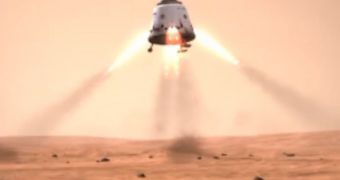Officials at the American space agency and the Hawthorne, California-based Space Exploration Technologies Corporation (SpaceX) are considering the possibility of developing a joint mission to search for signs of life on Mars.
The endeavor could be called Red Dragon, as it would be headed towards the Red Planet, and be carried out aboard a SpaceX Dragon capsule. The latter is being developed as a means of ferrying cargo, and eventually astronauts, to the International Space Station (ISS).
Relying on the company to provide the launch and delivery vehicles could make it a lot cheaper for NASA to conduct astrobiology research on our neighboring planet. With the responsibility of transport relegated to SpaceX, the agency could focus on the actual science instruments.
Red Dragon's main task would be to analyze the surface of Mars for any signs that life was, or still is, possible. About a billion years ago, geologists believe, the planet was criss-crossed by rivers, and even had an ocean in its northern hemisphere.
Past and current missions there – including Spirit, Opportunity, Phoenix, the Mars Reconnaissance Orbiter and so on – have provided ample evidence that that was indeed the case. All that remains is for science to confirm that life was able to develop there as well.
For scientists' experience to how life evolved and developed here on Earth, it's safe to assume that organisms would find a way to survive on the Red Planet, if they get a chance to emerge beforehand.
What is interesting about the new NASA/SpaceX partnership is that the Red Dragon mission could launch in as little as 7 years, and carry a cost of only $400 million. This is the price of an expensive satellite, or one of NASA's Deep Space missions.
“I just want a cheap delivery system to go to Mars. I don't care how it gets there,” says Chris McKay, who holds an appointment as an astrobiologist at the NASA Ames Research Center (ARC), in Moffett Field, California.
The expert and his team are the developers of the Red Dragon mission concept. The name is still being considered, but the group says that it would apply to have the mission included in the NASA Discovery program. The latter places emphasis on cheap space exploration.
For example, the three missions being considered for the next Discovery mission are capped at around $425 million, not including the price of the delivery system that will take them to their destination.
In about a year and a half, NASA will issue another call for proposals to include in the Discovery program, and the ARC team plans to have Red Dragon prepared for inspection and approval by that time.
The spacecraft could land either at Phoenix Mars Lander's or at Viking 2's locations. Both these regions are known for harboring ice deposits just beneath the surface, Space reports.

 14 DAY TRIAL //
14 DAY TRIAL //